The World Economic Forum's Annual Meeting 2022 resonated with two themes that have assumed indisputable prominence in global discourse. One, the imperative of addressing the looming and real danger of climate change and the collective actions needed to move towards a sustainable path of development. Amid the ongoing global uncertainty around energy availability, the sustainability debate has snowballed into an even more urgent movement. Two, the growing consensus that India will play a central role in driving global growth. It was particularly noteworthy to see the forum reverberate with the India story. reinforcing Prime Minister Modi's pronouncement of "when India grows, the world grows: when India reforms, the world transforms".
These two themes dovetail perfectly when one considers that India is among the leading nations to have adopted large-scale sustainable development practices. India is building resilient and sustainable socio-economic infrastructure that is reducing our carbon footprint even as it is uplifting millions of citizens from poverty.
Through tangible impact on the ground, the honourable Prime Minister has convinced the nation that ecological sustainability and economic progress can go hand-in-hand.
This approach is at variance with the traditional success stories of many Western and some Asian economic powerhouses which were propelled by carbon-intensive industries. For years, climate change geopolitics was predicated on developed economies bearing the lion's share of mitigation, and rightfully so, as they have been the largest emitters of greenhouse gases (GHG) historically. It was considered unfeasible to impose the same burden on developing economies. India has fundamentally altered that understanding by pledging comprehensive targets while also meeting its socio-economic objectives. This transition from a follower to a leader has been eight years in the making.
Nowhere is this truer than in the economics of energy. Despite the fact that our per capita energy demand increased by over 60% in the last two decades, India's energy use and emissions have remained less than a third of the global average. According to the World Bank, India had per capita emissions of 1.8 tonnes CO2 equivalent in 2018 - well below the global average of 4.5 tonnes. Owing to a rich civilisational legacy that has promoted ecological harmony, we are acutely aware of our environmental responsibilities towards future generations even as we aim to reach high levels of economic growth. Much like steering a ship, transitioning towards decarbonisation will take time and require calibrated, nuanced measures that ensure India's current developmental targets are not compromised even as we look towards a net-zero future.
Last year's COP-26 Summit in Glasgow provided an apt demonstration of why India will succeed on the vitals of sustainability. Prime Minister Modi stunned and inspired the world when he announced India's aggressive agenda against climate change through the Panchamrit Action Plan which India becoming a net-zero emissions country by 2070. This is one of the shortest time spans proposed between peak emissions and net zero status by a developing economy - reiterating India's firm belief that the roadmap to prosperity lies in sustainability. The Prime Minister also committed that by the end of this decade, India will meet 50 percent of its energy requirements from renewable energy, installed capacity of non-fossil-fuel energy in India will stand at 500 GW; emissions intensity of the country's GDP will drop by 46-48 percent from 2005 levels, and that its carbon emissions will be lower by one billion tonnes.
The Prime Minister has held environmental protection as an article of faith since his days as Chief Minister of Gujarat. It explains why he conceptualised the 102-member International Solar Alliance (ISA) in 2015, and why India embarked upon an ambitious path of sustainable development through the Intended Nationally Determined Contribution (INDC) under the Paris Agreement of COP-21 as well as the commitments at COP-26. have no doubt that India will achieve these targets alongside economic imperatives. My optimism stems from the fact that have had the good fortune of closely observing his vision in two vital components of India's sustainable growth paradigm: urban development and energy transition.
India's flagship urban programmes were launched almost a year before the SDGs were adopted globally. Even as we approximate towards the targets of SDG 11 (Sustainable Cities and Communities), I am confident that the improved urban ecosystems will result in positive impact on other SDGS related to poverty, health, education, energy, and industry and innovation. Most of the housing developed under Pradhan Mantri Awas Yojana - Urban (PMAY) utilises sustainable and energy-efficient methods which incorporate advanced practices of land-use planning and green technologies. TERI has estimated that this will mitigate approximately 12 million metric tonnes (MMT) CO2 equivalent of GHG emissions. In the Atal Mission for Rejuvenation and Urban Transformation (AMRUT) mission, more than 49 MMT of CO2 equivalent of GHG emissions are being reduced even as basic civic amenities are provided. Additionally, there has been an emphasis to transition towards public transport and mobility options-more than 12.65 MMT of GHG emissions are expected to be reduced through the 773 kms of metro line that are already operational in 18 cities as well as a network of 1,006 kms which is under construction in 27 cities.
While India is optimising its energy consumption through targeted interventions in urban areas, it is also maximising its energy production efforts by working towards doubling the share of natural gas-which is much less polluting than fossil fuels in our energy mix by 2024, India's aggressive policy of adoption of natural gas has led to GHG emissions mitigation of 566 MMT between 2014-15 and 2021-22. Aligned with this is the National Hydrogen Mission which will create an ecosystem for the production of Green Hydrogen. By 2030, India aims to produce 4 metric tonnes (MT) of Green Hydrogen annually and accrue more than Rs. 1 lakh crores of fossil fuel import savings. We have also increased ethanol blending in petrol from 0.67% in 2012 to 10% in 2022 and recently advanced the target of ramping it up to 20% by 2025-26 instead of 2030. The Ujjwala scheme has become a global case study for access to clean energy. It has freed our rural women from the shackles of the fireplace and given an entirely new dimension to the concept of 'gender justice'.
As we celebrate the World Environment Day today, it is worth taking pride in how far India has come in balancing economic growth, social equality and environmental sustainability. We have progressed from energy scarcity to energy justice, and are now moving towards energy security through collaborative and integrated action. In doing so, we are setting a new standard for the collective fight against climate change.

PM Sh Narendra Modi Ji has done the unthinkable in Bihar and it will change the grammar and lexicon of Indian politics for the ti...
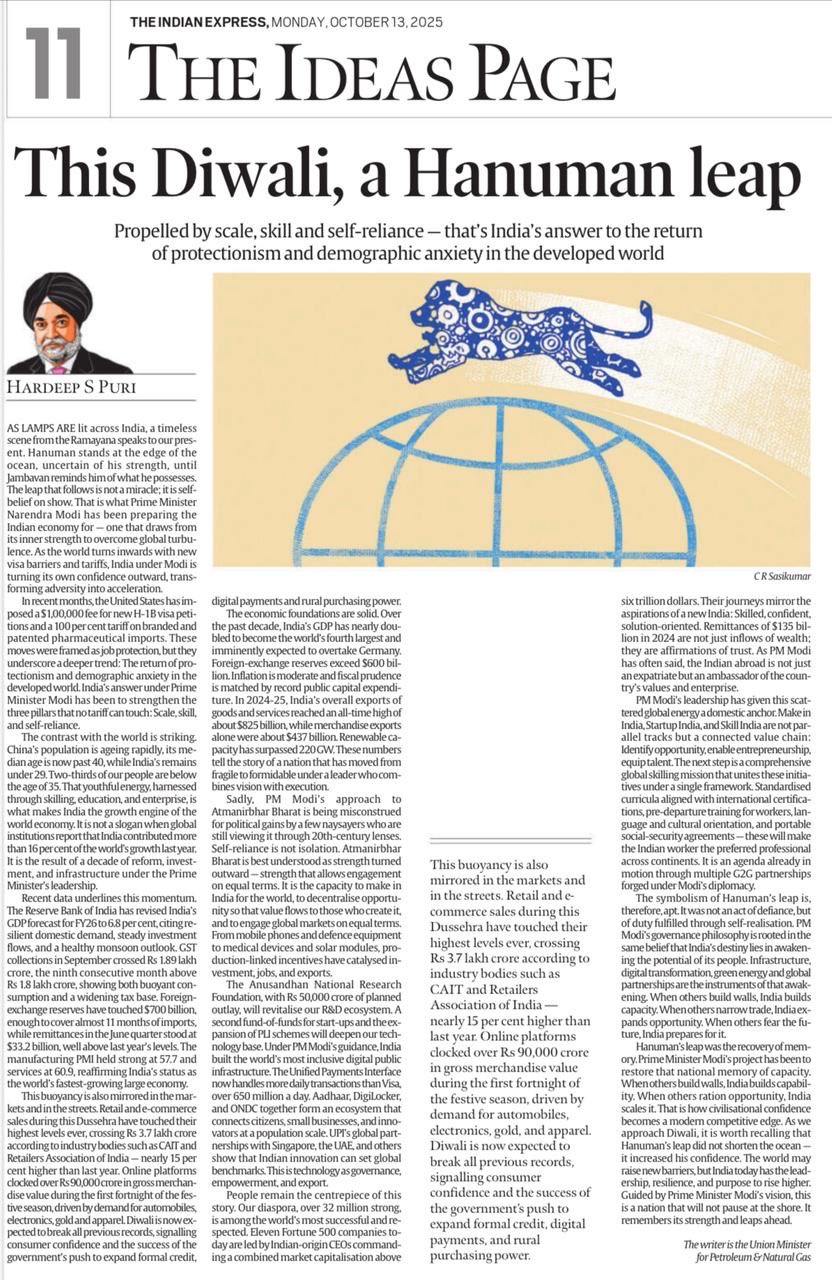
As the world passes through a period of geopolitical turmoil and uncertainty, India, under the visionary & decisive leadership of ...
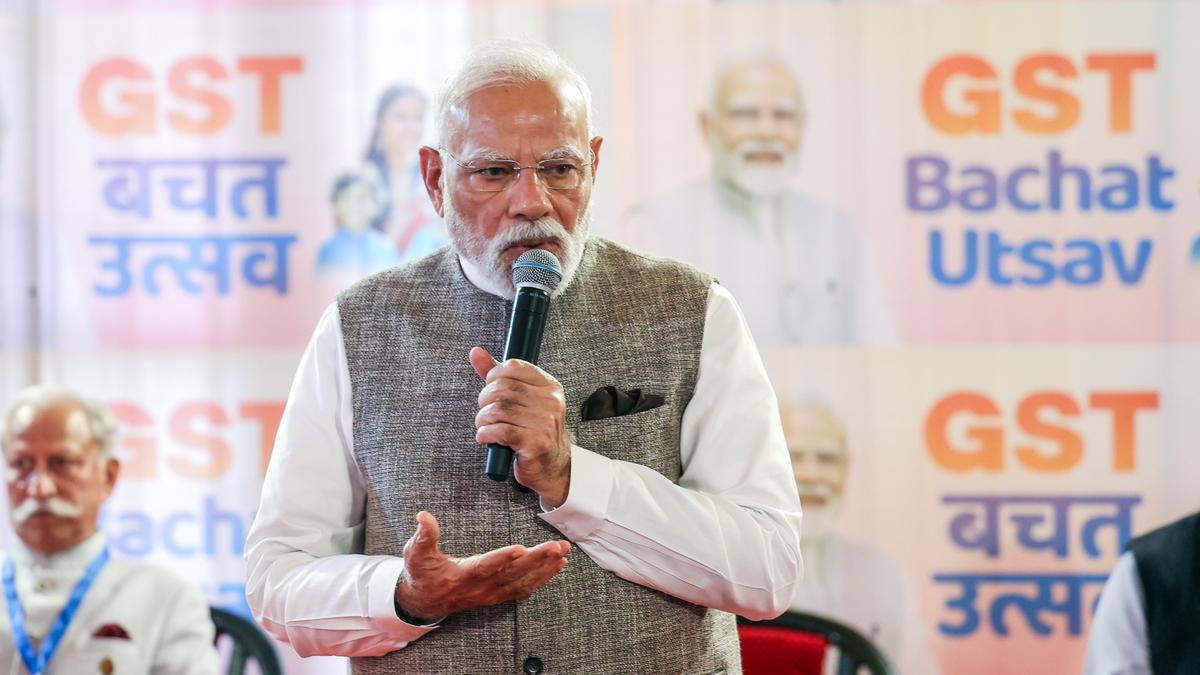
The Prime Minister’s professionalism and work ethic are what make the difference on the ground Praise has been showered on Pr...
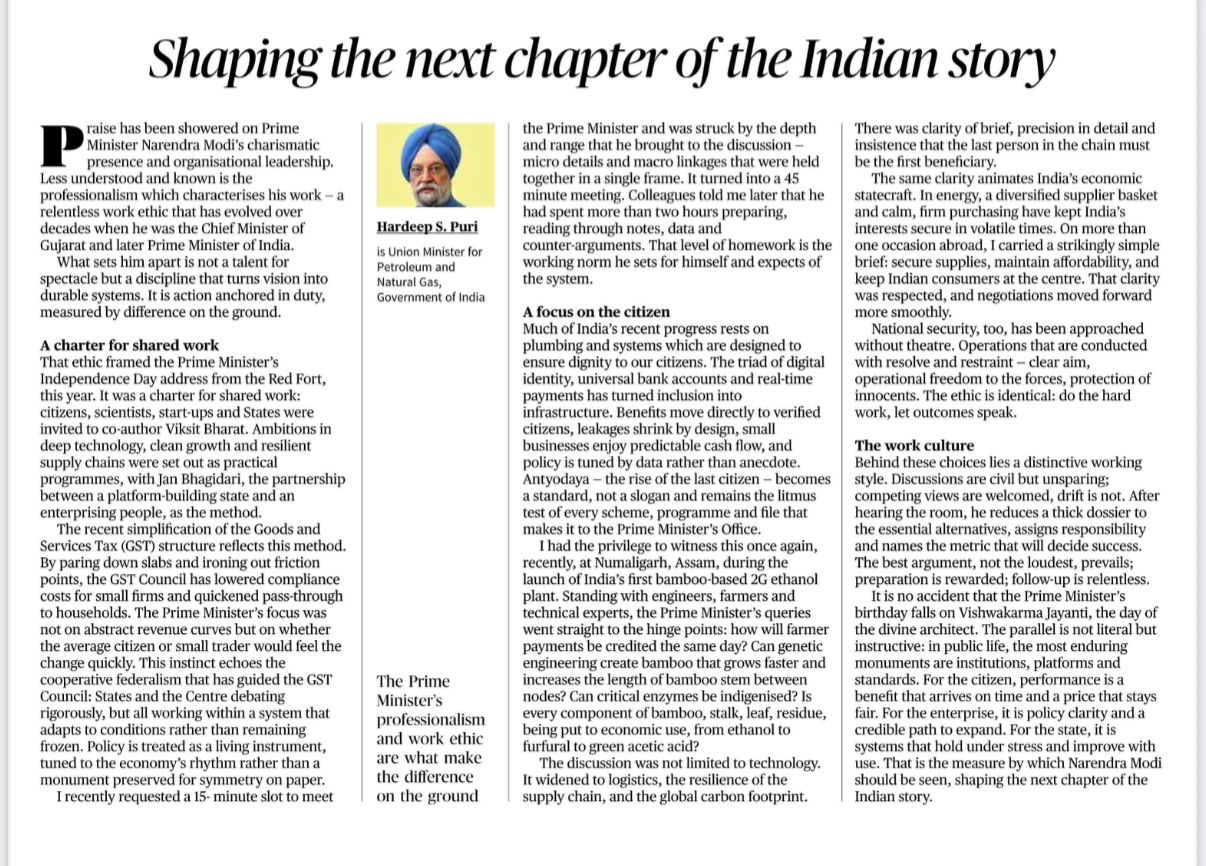
Shaping the next chapter of the Indian story!...
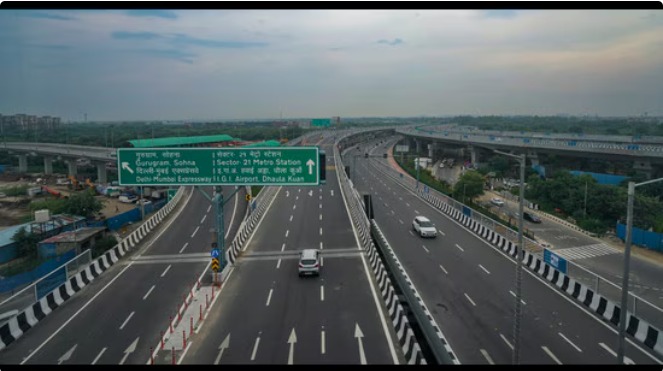
Indian cities are again on that path to being modern yet humane, ambitious yet inclusive, global in outlook yet rooted in our valu...

India’s fact-rich story of resilience, growth and energy security will silence the ‘global doubters’ who call it a ‘dead e...
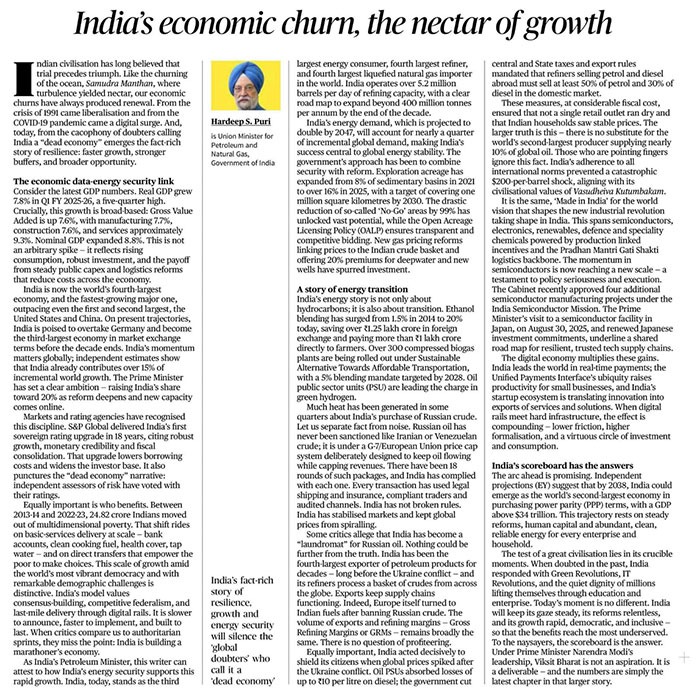
The test of a great civilisation lies in its crucible moments. When doubted in the past, India responded with Green Revolutions, I...
.jpeg)
विकसित भारत के लिए प्रधानमंत्री श्री नरेंद्र मोद...
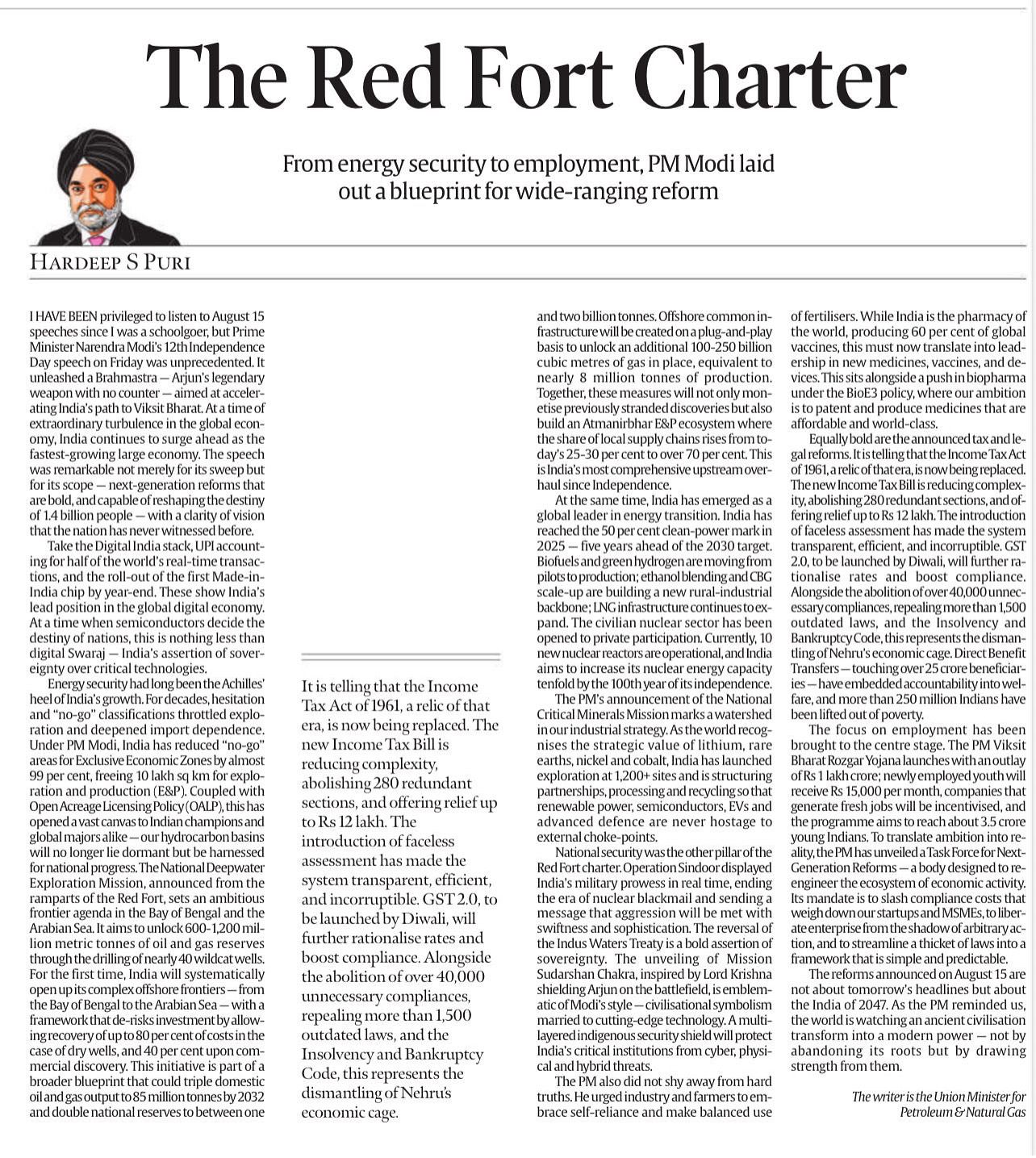
PM Sh Narendra Modi Ji’s unprecedented 12th Independence Day speech was remarkable for its sweep and scope. The speech which un...